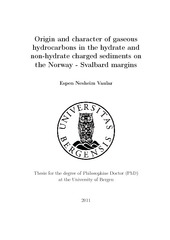| dc.contributor.author | Vaular, Espen Nesheim | eng |
| dc.date.accessioned | 2011-07-04T15:36:22Z | |
| dc.date.available | 2011-07-04T15:36:22Z | |
| dc.date.issued | 2011-05-26 | eng |
| dc.identifier.isbn | 978-82-308-1765-0 (print version) | en_US |
| dc.identifier.uri | https://hdl.handle.net/1956/4824 | |
| dc.description.abstract | Gas incubated in clathrate water-structures, stabilizes the hydrogen bonded substance termed gas hydrate. In the marine environment vast amount of carbon is stored as gas hydrates within the temperature and pressure zone these ice-like structures are stable. Natural gas hydrate mapping and characterization is important basic research that brings about critical knowledge concerning various topics. Natural gas hydrates is a vital part of the carbon cycle, it is a potential energy resource (and thereby a potential climate agent) and it is a potential geo-hazard. One of the goals the GANS initiative aimed at exploring, was the hydrate bearing sediment of the Norway -Svalbard margins, to investigate the character and expansion of natural gas hydrates. Part of the investigation was to define how the gas in the hydrated sediment was produced and where it came from. As a result this thesis addresses the matter of light hydrocarbon characterization and origin in two Norwegian hydrate deposits. On cruises to Vestnesa on the Svalbard margin and to Nyegga in the mid-Norwegian margin, samples of hydrate charged and non-hydrate charged sediments were obtained and analyzed. Through compositional and isotopic analyses the origin of the hydrate bound gas in the fluid escape feature G11 at Nyegga was determined. The hydrate incubated methane is microbial produced as well as parts of the hydrate bound ethane. The compositional analysis in both the Nyegga area and at the Vestnesa Ridge points at thermogenic contributions in the sediment interstitials and pore water. The two hydrate bearing margins show large differences in hydrocarbon content and microbial activity in the pockmarks investigated. The gravity cores from the penetrated pockmark at Vestnesa showed low hydrocarbon content and thus suggest ceased or periodic venting. The fluid flow escape features at Nyegga show large variety of flux rates based on ROV monitoring and headspace analysis of the sediment and pore water. The light hydrocarbon content varies largely both between the pockmarks and within a single pockmark. Laboratory experiments have been preformed to consider the carbon isotope fractionation effect of hydrate formation. The experiments display minor fractionation with contrasting fractionation effects of carbon isotopes when forming methane hydrates and structure two hydrates of methane, ethane and propane. This does not inflict with the interpretation of the isotopic signature of the hydrated deposits at Nyegga. Thus the proposed microbial carbon circulation in the free gas zone beneath the gas hydrate stability zone is withheld as the probable root of the light isotopic signature. | en_US |
| dc.language.iso | eng | eng |
| dc.publisher | The University of Bergen | en_US |
| dc.relation.haspart | Paper I: Organic Geochemistry 41(5), Vaular, E.; Barth, T. and H. Haflidason, The geochemical characteristics of the hydrate-bound gases from the Nyegga pockmark field, Norwegian Sea, pp. 437-444. Copyright 2010 Elsevier. Full-text not available in BORA due to publisher restrictions. The published version is available at:<a href="http://dx.doi.org/10.1016/j.orggeochem.2010.02.005" target="blank">http://dx.doi.org/10.1016/j.orggeochem.2010.02.005</a> | en_US |
| dc.relation.haspart | Paper II: Vaular, E.; Haflidason, H. and T. Barth, Comparison of Vestnesa and Nyegga Pockmark Fields using light hydrocarbon parameters for geochemical profiling. Submitted to Marine Geology. Full-text not available in BORA. | en_US |
| dc.relation.haspart | Paper III: Vaular, E.; Barth, T. and D. Corak, Carbon isotope fractionation during hydrate formation at Nyegga - Norwegian Sea, a case study. Submitted to Chemical Geology. Full-text not available in BORA. | en_US |
| dc.title | Origin and character of gaseous hydrocarbons in the hydrate and non-hydrate charged sediments on the Norway - Svalbard margins | en_US |
| dc.type | Doctoral thesis | |
| dc.rights.holder | The author | en_US |
| dc.rights.holder | Copyright the author. All rights reserved | en_US |
| dc.subject.nsi | VDP::Mathematics and natural science: 400::Chemistry: 440 | en_US |
